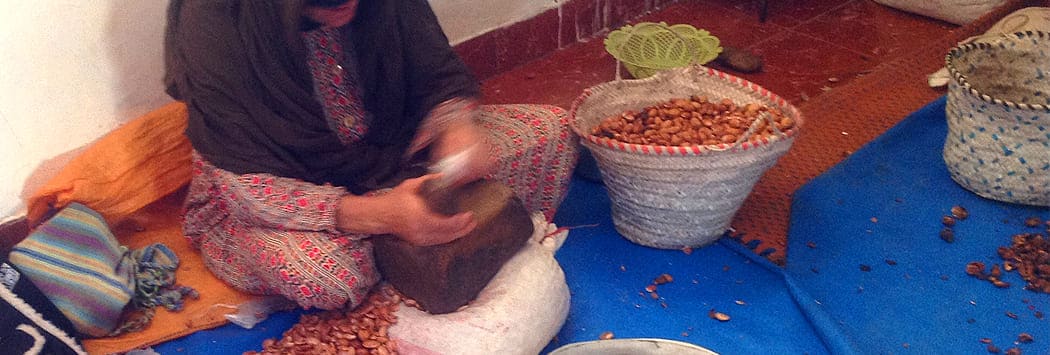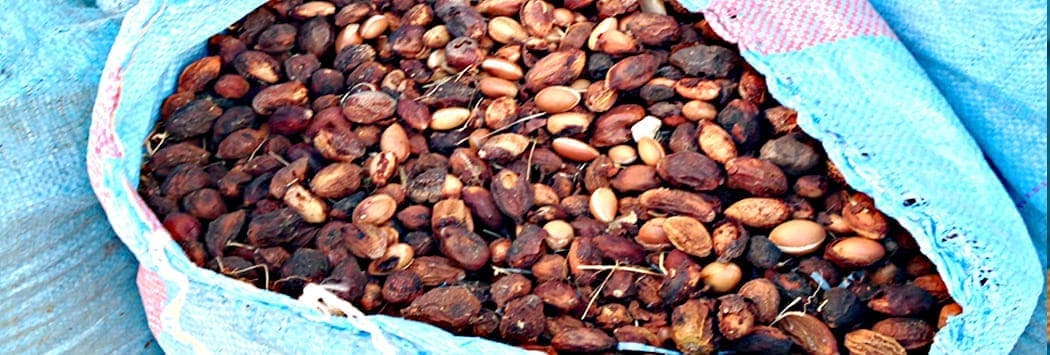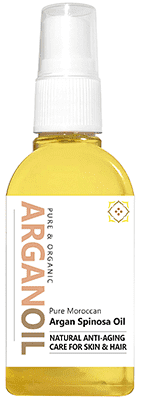What is Argan Oil?

It grows very slowly and produces a green fruit containing a nut which has 3 milky white, oil-rich kernels.
These nut kernels are extracted by hand by Berber women in cooperatives and cold-pressed into pure Argan Oil. The oil is totally natural, organic and also vegan friendly.
Buy Argan Oil & Cactus Seed Oil ►
Where Does Real Argan Oil Come From?
The Argan Tree
Argan Oil comes from the Argan tree which grows in Morocco. It is an ancient tree that is a relic of the Earth’s Tertiary Period which ended about 1.6 million years ago.
Argan trees grow in arid, salty soil and grow most prolifically near the coast and in the low mountains.
You will find the densest Argan forests in a narrow band of the country between Essaouira and Agadir.
The tree may grow up to ten meters tall and can live for over 200 years.
It has small leaves 2–4 cm long and silver-green in colour. In April it produces small flowers with five pale yellow-green petals.
The Argan fruit that it produces is 2 to 4 cm long and 1.5 to 3 cm in diameter. Each fruit has a thick, fleshy, bright green peel surrounding the hard nut held inside.
Argan trees will grow on mountain slopes in very arid regions. They protect soil against water loss as well as rain or wind-induced erosion.
This helps to maintain soil fertility and slows down desertification. A hybrid version of the Argan tree in israel is actually being grown in an attempt to reclaim arid desert lands.
Argan trees and the forests are owned by communities or individual families.
The size of the forest had been in decline after decades of misuse leaving the tree’s survival endangered. Villagers used wood from the trees for heating and making charcoal.
They grazed their livestock – goats and camels – on the Argan tree leaves and fruits. This has continued for many years resulting in a deterioration in the quality of the forests.
Now the income generated for the communities by the Argan tree has brought new respect for the forests. With the increased demand for Argan Oil new trees and being planted and the Argan forests expanded.
To protect the tree, UNESCO declared the area in which the Argan tree grows a “biosphere reserve”.
The reserve covers more than 2,560,000 hectares and is bordered by the High Atlas and Anti-Atlas Mountains and open to the Atlantic in the west.
Programs have also been put in place to help protect the trees from being used for grazing by goats and camels. International support and modernisation of Argan Oil production have become a model for Agro-Forestry and the cooperative system of working.
The Berber Women’s Cooperatives

Argan Oil is made almost exclusively by the Berber women’s cooperatives of Morocco.
The cooperative movement was started in part Professor Zoubida Charrouf and others to help Berber communities compete with the foreign-owned pressing plants.
Professor Charrouf’s work lead to NGOs from Europe and Morocco providing funding for the development of cooperatives, investment in new mechanical presses, organic certification and buildings.
This has brought huge increases in income to the cooperatives and families of the region. Fairtrade has emancipated women by paying a fair, sustainable living wage.
Full Story & Video about Women’s Cooperatives ►
The Argan Oil Production Process

Harvest
Argan Oil is produced by groups of families that have owned areas of Argan trees for generations.
When the Argan fruits are ripe they are 2 cm or more long and bright green colour.
The Argan tree fruits are harvested in June or July.
To harvest the Argan fruits communities come together to complete the long and arduous job of getting the fruit off the trees with sticks and collecting them from the ground.
The bright green Argan tree fruits are left to dry until they form a dark brown husk around the Argan nut. These husks are stored in large sacks ready for the nuts to be extracted by the women of the community.
When ready to press oil the husks are removed to reveal the brown Argan nut. These nuts are hard to break and the process is still done by teams of women who crack the nuts open by hand.
Inside each nut are 2 or 3 pale yellow, bitter tasting kernels. Over 2 Kg of nut kernels are cold-pressed to extract one litre of pure oil.
Oil Extraction
After pressing the oil is filtered to yield a yellow coloured oil which has an Argan nut scent.
Oil Processing
This oil may also be filtered a second time to extract additional sediments and yield an oil that has almost no Argan nut smell – “deodorised” Argan Oil.
Culinary Argan Oil is produced by a slightly different process. To make an edible culinary Argan Oil the pale yellow nut kernels are toasted before being cold-pressed to extract the oil.
In-Depth Guide to How Argan Oil is Made ►
The Different Grades of Argan Oil.

Pure Argan Oil 2.03 fl oz
Pure double filtered Organic Argan Oil for a lighter Argan scent.
- 100% Pure Oil
- Certified Organic
- In Stock
- Quality Guarantee
- Free USPS 5-7 Day Tracked Shipping to U.S.
Now $21.22
There are two main types of Argan Oil.
Culinary Argan Oil and cosmetic Argan Oil.
Culinary Argan Oil is used for cooking and eating or nutritional supplements. It has a golden brown colour and a toasted, nutty smell.
Culinary Argan Oil is very rich in vitamins, omega fatty acids and other nutrients. It has been used in Morocco in traditional medicine for the treatment of health problems.
New research is now confirming the effects of culinary Argan Oil for health. Culinary Argan Oil is not suitable for cosmetic use.
The 3 Grades of Cosmetic Argan Oil.
– Single Filtered oil. This has a medium yellow colour and an Argan nut scent which is a natural olive/citrus smell.
– Filtered with Active Carbon. A small amount of oil production in Morocco is doubled filtered using active carbon. This is an inert compound that removes sediment without affecting theoil. Carbon filtered oil has a lighter yellow colour and has a more perfumed, sweeter smell less like olive.
– Double Filtered Oil. The purest grade of Argan Oil is filtered twice to remove all sediment. This oil has a pale yellow colour and almost no Argan nut fragrance.
You can buy both single filtered scented oil and odourless Argan Oil on our online store.
The Ultimate Guide to Argan Oil – Free Ebook
 |
This is a Free eBook about Pure Cosmetic and Culinary Moroccan Argan Oil.
Our 34 page eBook is a complete inside guide to the history of Argan Oil.
Learn about….
- the origins of the Argan Forests
- How Argan Oil is Made
- How the Berber Cooperatives Harvest Argan Oil
- The Chemistry of Argan Oil
- Culinary Argan Oil for Eating and Health
- How to use Cosmetic Argan Oil for Skin and Hair Care
What is in Moroccan Argan Oil?
A number of studies have been done to explain the traditional uses of Argan Oil for cosmetics and health. Argan Oil analysis has revealed some of the nutrients that are responsible for the effects of Argan Oil. This is a list of some of the most important nutrients in Argan Oil’s composition that give it it’s unique benefits:
Anti Oxidant Tocopherols – Argan Oil has over twice the Vitamin E content of Olive oil. These high antioxidant levels help prevent damage to the skin by “free radical” that age cells. Antioxidants in the Argan Oil chemical formula is also important for promoting cell proliferation. [1]
Essential Fatty Acids – Analysis of Argan Oil shows that it is very rich in Omega 6 and Omega 3 are healthy fatty acids. These fatty acids are essential to keep skin pliable and also play a role in reducing inflammation.
Triterpenoids – Argan Oil contains Triterpenoids. One of these Triterpenoids, called Tirucallol, has an important role in cicatrisation – which is the process that heals damage to the skin.
Beta Amyrine – Beta Amyrine is contained in many herbal products to stimulate cell growth and increase the healing process for skin damage. It has the ability to stimulate the cell to generate and to synthesise new collagen. It is reported to be beneficial in alleviating the symptoms of psoriasis. [1]
Butyrospermol – Butyrospermol has a powerful anti-inflammatory effect that may be of benefit in reducing inflammation of the skin and internal inflammation in problems such as Arthritis.
Lupenol – Lupenol has a strong antiseptic effect.
What is Moroccan Oil?
The Difference between “Moroccan Oil” and Argan Oil
Moroccan Oil is a name widely used to describe products which may or in many cases may not be genuine Argan Oil.
Genuine Argan Oil is produced from the nut kernel of the Argan tree in Morocco.
This is why some companies use the name Moroccan oil to refer to Argan Oil.
There is also a brand with the name “MoroccanOil”.
This is not pure Argan Oil but a hair treatment brand which does not claim to be pure Argan Oil but uses the name “MoroccanOil” as a brand only.
What is Argon Oil?
Argan Oil and Argon Oil….
Argon Oil is simply a mis-spelling of Argan Oil.
If you have been searching to learn about the benefits of “Argon Oil” hopefully you will not have come across any websites selling a product labelled “Argon”.
In fact if you find companies or websites advertising “Argon Oil”, incorrectly spelt, they are probably best avoided.
After all, if they have not checked that the name of their product is spelt correctly what chance is there that it is genuine Argan Oil!
Can I Buy Argan Oil Cheaper Elsewhere?
Be careful of very cheap Argan Oil – it does not exist.
For over 19 years we have worked only with genuine, authenticated suppliers that we know.
I was born in Morocco and my family are Berber. We started our by work directly with friends and family working in the Berber cooperatives.
Our goal is to increase trade for the cooperatives of Morocco that are making such a difference to women lives. So we keep our prices are as low as possible but for real, authentic, fair-trade, pure Argan Oil.
We avoid unnecessary packaging using light-weight packing to reduce environmental waste. This also allows us to offer free world-wide delivery for any order.

